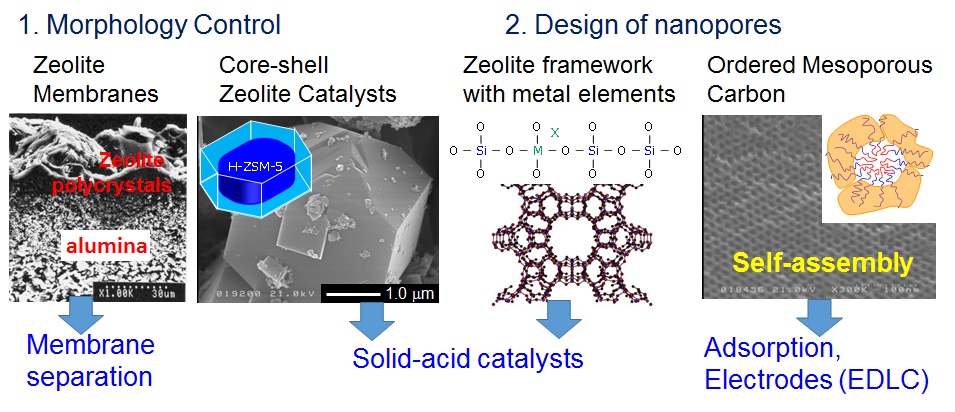Nishiyama Gr.
Synthesis of Nanoporous Materials and Their Applications
Nanoporous (microporous and mesoporous) materials such as zeolites and carbons are indispensable to the establishment of sustainable society. Our group has focused on (1) morphology control of nanoporous materials and (2) design of nanopores and (3) their use as catalysts, separation (adsorption, membrane) and electric devices (EDLC supercapacitors, Fuel cell).
<Zeolites Synthesis using Crsytal Overgrowth>
Development of new catalysts with high activity and selectivity is a key technology for the future chemical and petrochemical industry to reduce energy consumption. In the future society, biomass and natural gas including shale gas will play an important role as energy and material sources.
In particular, light olefins and benzene, toluene and xylene (BTX) are important petrochemical compounds in chemical industry. We prepared core-shell zeolite composite crystals consisting of an MFI structure by a zeolite over growth. The conversion to olefin and BTX, especially p-xylene from various C1-3 feedstocks on core-shell zeolite composites has been studied.
<Mesoprous Materials Synthesis using Self-assembly>
We have reported a vapor-phase synthesis of mesopous silica thin films using an self-assembly of organic-inorganic interactions [1]. Self-assembly by not only organic-inorganic interaction but also organic-organic interaction has been extensively utilized in the formation of mesostructured nanocomposite. My group has reported a soft-templating method using triblock copolymer for the synthesis of ordered mesoporous carbons [2]. We have controlled pore sizes and pore structures of carbons and carbon alloys (C-N). They show interesting properties in adsorption, EDLC supercapacitor, oxygen reduction reaction (ORR) activity in fuel cell.
[1] Tanaka, S.; Nishiyama, N. et al. J. Am. Chem. Soc. 2003, 126, 4854. [2] Tanaka, S.; Nishiyama, N. et al. Chem. Commun. 2005, 2125.




